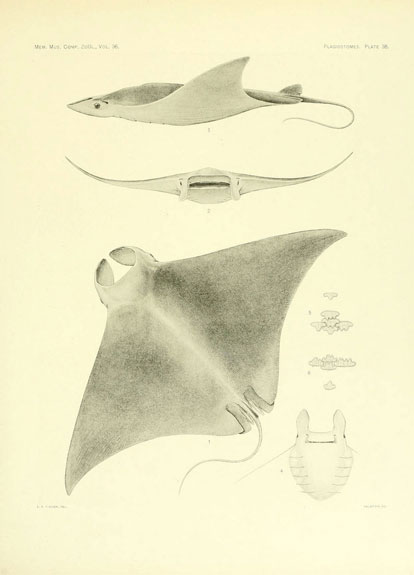Scientific Illustrations: Your Go-To Guides for Halloween Costumes
The details are what separate a good outfit from an amazing one. The images in the Biodiversity Heritage Library can help you make the leap
![]()
One of the core missions of the Smithsonian Institution is to understand and sustain a biodiverse planet. Many projects have been implemented across the Smithsonian with this noble intention. One of my personal favorites is the Biodiversity Heritage Library, for which the Smithsonian Institution Libraries is a founding member.
Launched in 2005, BHL is an impressive one-stop web-shop where researchers can access digital copies of thousands of scientific books and journals from 14 natural history museum libraries, botanical libraries and research institutions in the United States and the United Kingdom. Seven years into the ambitious undertaking, the digital library has collected over 39 million pages from nearly 57,000 titles. BHL has also uploaded over 45,000 impeccably detailed illustrations of plant and animal species to its Flickr account.
Scientists around the world report that BHL, in many ways, streamlines their research. The library has allowed botanist Joe Shaw, for instance, to locate the original descriptions of many species of cacti. Joachim Ladwig, an amateur fossil collector in Germany, used BHL to solve a 20-year mystery. By reading the original papers describing two species of cow sharks, he was able to unequivocally conclude that fossil teeth he unearthed belonged to Hexanchus microdon. Not to mention, BHL has allowed the National Museum of Natural History’s Chris Mah, one of the world’s leading experts on starfish, to download foreign texts about different species and quickly and easily translate them in Google Translate.
That said, nonscientists find uses for the catalog as well.
Recently, I found myself happily lost in the colorful creatures inhabiting BHL’s Flickr collections. From lions to lizards, hawks to herring, it is a virtual zoo! I was transfixed by an illustration (shown above) of Natalus stramineus, the Mexican funnel-eared bat, published in the Proceedings of the Zoological Society of London in the mid-19th century. The illustrator diagrammed certain physiological features, like the bat’s ears, in the way that an artist might in a study for a particular painting. In a strange way, the piecemeal analysis of the creature reminded me of a sewing pattern. My eyes wandered to an image of a lobster’s claws laid out like sleeves.
What great inspiration, I thought, for Halloween costumes!
If you are still looking for a costume idea, take a gander at these images culled from BHL. Study them, and when you are fashioning wings, ears, eyes and shells, pay close attention to detail. The more scientifically accurate you are, the more recognizable your getup will be!
Lobster
This illustration of two American lobsters, drawn from life, shows the antennae, walking legs, abdomen, tail fin and other anatomy of the crustacean. The red lobster is a two-pound female caught near Mount Desert, Maine, in 1894. Below her is a 1.5-pound male captured near Woods Hole, Massachusetts, in 1891. Decide if you want to be a miss or a mister, and note the differences in coloring.
Cobra
To dress as a cobra, model a homemade headdress after the hood of this Indian species, Naga tripudians. Decorate your hood with this realistic pattern of scales.
Butterfly
A butterfly is a simple costume to construct. Cut a pair of wings out of poster board; attach twine straps, and wear them like you would a backpack. Branch out from the familiar monarch butterfly, and consider painting your wings to resemble these lesser-known (at least in North America) species. The peacock butterfly (on the left), found in Britain, has “large compound eyelets, reddish in the centre, and the inner half of the outer circle of a rich golden yellow, the outer half being of a fine sky blue, with several dark spots in it,” according to The Book of Butterflies, Sphinxes and Moths (1832). The imperial trojan (on the right) is native to Ambon Island in Indonesia. Of this particular species, Carl Linnaeus said, “It may be doubted whether Nature has produced any object more beautiful amongst the insects.”
Great Horned Owl
Owls seem to be in vogue for Halloween. Whether you are crafting a mask or applying face paint, this illustration of a Great Horned Owl from the early 1900s may be a useful guide.
Tortoise
To pull off a tortoise costume, pick up a baggy sweatshirt. Paint the front and back of the shirt to match one of these shells, from two different tortoise species. Then, stuff the back of the sweatshirt with a pillow or several t-shirts.
Lesser Devil Ray
Fashion a cape in the shape of this eagle ray, known to live in the western Atlantic Ocean. The head of the ray can wrap around your own head. Add loops to the underside of the cape, at the tips of the ray’s wings; this way, you can slide your fingers in the loops and swim about.
For more ideas, explore BHL’s Flickr account!
/https://tf-cmsv2-smithsonianmag-media.s3.amazonaws.com/accounts/headshot/megan.png)







/https://tf-cmsv2-smithsonianmag-media.s3.amazonaws.com/accounts/headshot/megan.png)